|
|
 |
Fiche d'espèce de Copépode |
|
|
Calanoida ( Ordre ) |
|
|
|
Calanoidea ( Superfamille ) |
|
|
|
Calanidae ( Famille ) |
|
|
|
Canthocalanus ( Genre ) |
|
|
| |
Canthocalanus pauper (Giesbrecht, 1888) (F,M) | |
| | | | | | | Syn.: | Calanus pauper Giesbrecht,1888; 1892 (p.91, 129, figs.F,M); Giesbrecht & Schmeil, 1898 (p.16); Thompson & Scott, 1903 (p.232, 241); Wolfenden, 1905 (p.995, figs.M); Carl, 1907 (p.18); A. Scott, 1909 (p.9); Wolfenden, 1911 (p.193: Rem.); Pesta, 1912 a (p.43, figs.F,M); 1913 (p.30); Fox, 1929 (p.843, Rem.: p.851); Farran, 1929 (p.207, 215, Rem.); Dakin & Colefax, 1933 (p.204); Farran, 1936 a (p.77); Mori, 1937 (1964) (p.18, figs.F,M); Chiba & al., 1957 (p.306); 1957 a (p.11); Brodsky, 1972 (1975) (p.9, 88, figs.); Vyshkvartzeva, 1976 (p.14); 1977 a (p.97, figs.); Cervantes-Duarte & Hernandez-Trujillo, 1989 (tab.3); Yoo, 1991 (tab.1); Palomares Garcia & Vera, 1995 (tab.1); Smith S. & al., 1998 (p.2369, Table 6, moonsoon effects): Dolganova & al., 1999 (p.13, tab.1); Maiphae & Sa-ardrit, 2011 (p.641, Table 2) | | | | Ref.: | | | A. Scott, 1909 (p.9); Sewell, 1912 (p.353, 355: Rem.F); 1914 a (p.193, Rem.); Früchtl, 1924 b (p.12, figs.M); Gurney, 1927 (p.143, Rem.); Sewell, 1929 (p.25); Früchtl, 1924 b (p.12, 32, figs.); Dakin & Colefax, 1940 (p.85, figs.F,M); Vervoort, 1946 (p.36, Rem.); Sewell, 1947 (p.16); C.B. Wilson, 1950 (p.184, figs.F,M); Tanaka, 1956 (p.260); 1960 (p.19); Grice, 1962 (p.177, figs.F,M); Brodsky, 1962 c (p.102, figs.F,M); Kasturirangan, 1963 (p.12, figs.F,M); Chen & Zhang, 1965 (p.29, figs.F,M); Saraswathy, 1966 (1967) (p.74); Brodsky, 1972 (1975) (p.72, 88, 116, 121, figs.F,M); Grice, 1972 (p.177, figs.F,M); Bradford & Jillett, 1974 (p.6, fig.F); Greenwood, 1976 (p.7, figs.F,M); Marques, 1982 (p. 750, fig.F); Zheng Zhong & al.,1984 (1989) (p.226, figs.F,M); Fleminger, 1985 (p.276, 285, Table 1, 4, fig.M, Rem.: A1); Bradford, 1988 (p.74, 76, 79, Rem.); Nishida, 1989 (p.173, table 2, no M dorsal hump); Bradford-Grieve, 1994 (p.35, figs.F,M); Chihara & Murano, 1997 (p.739, Pl.65: F,M); Bradford-Grieve & al., 1999 (p.877, 907, figs.F,M); Al-Yamani & Prusova, 2003 (p.23, figs.F,M); Conway & al., 2003 (p.144, figs.F,M, Rem.); Boxshall & Halsey, 2004 (p.81: fig.F); Mulyadi, 2004 (p.15, figs.F,M, Rem.); Phukham, 2008 (p.111, figs.F,M); Al-Yamani & al., 2011 (p.12, figs.F,M); Lacuna & al., 2013 (p.68, figs.M, Rem.) |  issued from : J.M. Bradford & J.B. Jillett in Crustaceana, 1974, 27 (1). [p.14, Fig.2, A]. Female: A, P1.
|
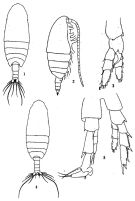 issued from: Q.-c Chen & S.-z. Zhang in Studia Marina Sinica, 1965, 7. [Pl.3, 1-5]. Female (from E China Sea): 1, habitus (dorsal); 2, idem (lateral right side); 3, P1 (anterior). Male: 4, habitus (dorsal); 5, P5 (posterior).
|
 issued from : J.G. Greenwood in Proc. R. Soc. Qd, 1976, 87. [p.9, Fig.3, a-b]. Female (from Moreton Bay): a, P1. Male: P5.
|
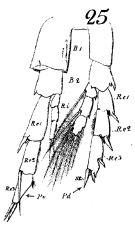 issued from : W. Giesbrecht in Fauna Flora Golf. Neapel, 1892, 19. [Taf.8, Fig.25]. As Calanus pauper. Male: 25, P5 (posterior surface).
|
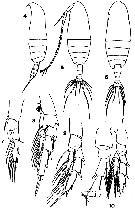 issued from : T. Mori in The pelagic Copepoda from the neighbouring waters of Japan, 1937 (1964). [Pl.6, Figs.4-10]. As Calanus pauper. Female: 6, habitus (dorsal); 7, P1 (without endopod; anterior view); 8, P2; 9, P5. Male: 4-5, habitus (lateral and dorsal, respectively); 10, P5 (posterior view).
|
 issued from : G.D. Grice in Fish. Bull. Fish and Wildl. Ser., 1962, 61. [p.176, Pl.1, Figs.9-18]. Female (from equatorial Pacific): 9-10, habitus (dorsal and lateral, respectively); 11, posterior paert of thorax and urosome (dorsal); 12, endopod of P1 (lateral view); 13, 1st and 2nd basipodal segments of P1 (oblique view); 14, P5. Male: 15, habitus (lateral); 16, posterior part of thorax and urosome (dorsal); 17, P5; 18, distal two segments of left P5.
|
 issued from : A. Fleminger in Mar. Biol., 1985, 88. [p.284, Fig.6 C]. Male (from SE Inian, SW Pacif, tropical): Left A1 proximal segments (ventral view); Nota: see remarks in Calanus s.l. pacificus californicus (Fleminger, 1985, p.275) concerning the dimorphism in the female A1.
|
 Issued from : W. Giesbrecht in Systematik und Faunistik der Pelagischen Copepoden des Golfes von Neapel und der angrenzenden Meeres-Abschnitte. - Fauna Flora Golf. Neapel, 1892, 19 , Atlas von 54 Tafeln. [Taf.6, Fig.4]. Male: 4, habitus (dorsal).
|
 issued from : N. Phukham in Species diversity of calanoid copepods in Thai waters, Andaman Sea (Master of Science, Univ. Bangkok). 2008. [p.194, Fig.68]. Female (from W Malay Peninsula): a, habitus (dorsal); b, urosome (dorsal); c, P1. Male: d, habitus (dorsal); e, urosome (dorsal); f, P5. Body length after the drawings: F = 1.392 mm; M = 1.200 mm.
|
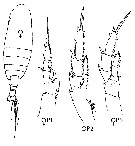 issued from : J.M. Bradford-Grieve, E.L. Markhaseva & C.E.F. Rocha & B. Abiahy in South Atlantic Zooplankton, Edit. D. Boltovskoy. 1999. Vol.2. Copepoda. [p.980, Fig. 7.16]. Female: habitus (dorsal); P1; P2; P5.
|
 issued from : J.M. Bradford-Grieve, E.L. Markhaseva & C.E.F. Rocha & B. Abiahy in South Atlantic Zooplankton, Edit. D. Boltovskoy. 1999. Vol.2. Copepoda. [p.980, Fig. 7.16]. Male: habitus (dorsal); P5 (I = left leg; r = right leg).
|
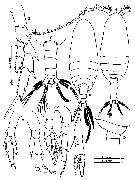 issued from : Mulyadi in Published by Res. Center Biol., Indonesia Inst. Sci. Bogor, 2004. [p.16, Fig.5]. Female (from Indonesian Seas): a, habitus (dorsal); c, P1; d, P5. Male: b, last thoracic segment and genital segment (lateral); e, habitus (dorsal); f, urosome ( (dorsal); h, P5; g, P5 from other specimen.
|
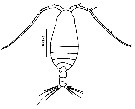 ssued from : M.L.D.G. Lacuna, D.C. Sagrado, R.O. Mejorada, D.D. Simyunn & M.J.J. Pueblos in ABAH Bioflux, 2013, 5 (1). [p.68, Fig.19]. Male (from Sarangani Bay, Mindanao): habitus (dorsal).
|
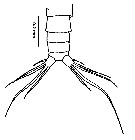 ssued from : M.L.D.G. Lacuna, D.C. Sagrado, R.O. Mejorada, D.D. Simyunn & M.J.J. Pueblos in ABAH Bioflux, 2013, 5 (1). [p.69, Fig.20]. Male: urosome.
|
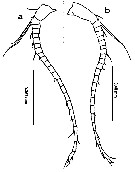 ssued from : M.L.D.G. Lacuna, D.C. Sagrado, R.O. Mejorada, D.D. Simyunn & M.J.J. Pueblos in ABAH Bioflux, 2013, 5 (1). [p.69, Fig.21]. Male: a, left A1; b, right A1. Nota: A1 with 23 segments
|
 ssued from : M.L.D.G. Lacuna, D.C. Sagrado, R.O. Mejorada, D.D. Simyunn & M.J.J. Pueblos in ABAH Bioflux, 2013, 5 (1). [p.70, Fig.22]. Male: a, P1; b, P2; c, P3; d, P4; e, P5. Nota: P5 asymmetrical. Left leg 3-segmented, prehensile and flexed outward; endopod end with 2 terminal setae; exopod with 1 seta on the outer region of the 2nd segment and 2 apical setae on the 3rd segment. Right leg 3-segmented, with exopod without inner marginal setae.
|
 Issued from : V.N. Andronov in Russian Acad. Sci. P.P. Shirshov Inst. Oceanol. Atlantic Branch, Kaliningrad, 2014. [p.73, Fig.19, 8]. Canthocalanus pauper after Wolfenden, 1906. Male P5.
|
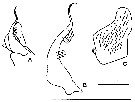 Issued from : J.A. Fornshell & F.D. Ferrari in Crustaceana, 2014, 87 (1). [p.106, Fig.2, A-C]. Von Vaupel Klein's organ on right endopodal segment 1 and right basal seta of P1. A, anterior, distal up (denticles and pores not drawn; B, right basal seta; C, proximal endopodal segment (showing pores and denticles) Scale line; short = 50 µm; long = 140 µm. The Von Vaupel Klein organ is an association (srtucture) of the distal seta from basis and the proximal endopodal segment of P1. This structure shows significant variability among many gymnoplean copepods, in the shape of the distodorsal corner of the proximal endopodal segment, presence and location of denticles on the anterior face of the segment, presence and size of denticles along the distal margin of the segment , number of pores on the segment, shape of the seta that originates on the basis, and the morphology of the basis at the origin of the seta. The function of this complex structure is not known.
|
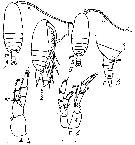 Issued from : M.C. Kos in Field guide for plankton. Zool Institute USSR Acad., Vol. I, 1972. As Calanus (Canthocalanus) paoper. After Brodsky, 1962
| | | | | Ref. compl.: | | | Wilson, 1942 a (p.176); Sewell, 1948 (p.322); Krishnaswamy, 1953 (p.107); Yamazi, 1958 (p.147); Fagetti, 1962 (p.14); Ganapati & Shanthakumari, 1962 (p.7, 15); De Decker, 1964 (p.15, 28); De Decker & Mombeck, 1964 (p.11); Grice & Hulsemann, 1967 (p.18); Fleminger, 1967 a (tabl.1); Itoh, 1970 (tab.1); Timonin, 1971 (p.281, trophic group); Subbaraju & Krishnamurphy, 1972 (p.25, 26 ); Heinrich, 1973 (p.95); Patel, 1975 (p.659); Carter, 1977 (1978) (p.35); Madhu Pratap & al., 1977 (p.138, Table 3: abundance vs. stations); Chen Q-c, 1980 (p.794); Sreekumaran Nair & al., 1981 (p.493, fig.2 cont.); Dessier, 1983 (p.89, Tableau 1, 2, Rem., %); Guangshan & Honglin, 1984 (p.118, tab.); De Decker, 1984 (p.315, 338: chart); Binet, 1984 (tab.2, 3); 1985 (p.85, tab. 3); Brinton & al., 1986 (p.228, Table 1); Chen Y.-Q., 1986 (p.205, Table 1: abundance %, Table 2: vertical distribution); Sarkar al., 1986 (p.178); Madhupratap & Haridas, 1986 (p.105, tab.1); Renon, 1987 (tab.2); Jimenez-Perez & Lara-Lara, 1988; Williams D. & al., 1988 (p.580); Dessier, 1988 (tabl.1); Hirakawa & al., 1990 (tab.3); Othman & al., 1990 (p.561, 563, Table 1); Madhupratap & Haridas, 1990 (p.305, fig.6: vertical distribution night/day; fig.7: cluster); McKinnon, 1991 (p.471); Dai & al., 1991 (tab.1); Gajbhiye & al., 1991 (p.188); Gajbhiye & Abidi, 1993 (p.137 as C. papur); Shih & Young, 1995 (p.68); Madhupratap & al., 1996 (p.866); Padmavati & Goswami, 1996 a (p.85, fig.2, 3, Table 4, vertical distribution); Ramaiah & al., 1996 (p.3); Ramaiah & Nair, 1997 (tab.1); Park & Choi, 1997 (Appendix); Sharaf & Al-Ghais, 1997 (tab.1); Go & al., 1997 (tab.1); Padmavati & al., 1998 (p.349); Nair & Ramaiah, 1998 (p.272, fig.4); Noda & al., 1998 (p.55, Table 3, occurrence); Achuthankutty & al., 1998 (p.1, Table 2, fig.6, seasonal abundance vs monsoon); Stephen, 1998 (p.340, 341, chart); Hwang & al., 1998 (tab.II); Hsieh & Chiu, 1998 (tab.2); Wong & al, 1998 (tab.2); Suarez-Morales & Gasca, 1998 a (p108); El-Serehy, 1999 (p.172, Table 1, occurrence); Lavaniegos & Gonzalez-Navarro, 1999 (p.239, Appx.1); Fernandez-Alamo & al., 2000 (p.1139, Appendix); Dalal & Goswami, 2001 (p.22, fig.2); Madhupratap & al., 2001 (p. 1345, vertical distribution vs. O2, figs.4, 5, Rem.: p.1353: clusters); Greenwood & al., 2002 (p.17, Table 2); Lo & al., 2001 (1139, tab.I); Osore & al., 2003 (p.69); Hwang & al., 2003 (p.193, tab.2); Shimode & Shirayama, 2004 (tab.2); Hsiao & al., 2004 (p.325, tab.1); Hsieh & al. 2004 (p.397, tab. 1, p.399, tab.2); Rezai & al., 2004 (p.486, tab.2, 3, abundance, Rem.); Lo al.*, 2004 (p.218, tab.1, fig.6); Lo & al., 2004 (p.468, tab.2); Chang & Fang, 2004 (p.456, tab.1); Lan & al., 2004 (p.332, tab.1, tab.2); Gallienne & al., 2004 (p.5, tab.3); Satapoomin & al., 2004 (p.107, tab.4); Yin & al., 2004 (p.3); Lo & al., 2004 (p.89, tab.1); Kazmi, 2004 (p.230); Wang & Zuo, 2004 (p.1, Table 2, dominance, origin); Shimode & al., 2005 (p.113 + poster); Alvarez-Silva & al., 2005 (p.39); Smith & Madhupratap, 2005 (p.214, tab.4,5); Rezai & al., 2005 (p.157, Table 2, 5: spatial & temporal variations); Prusova & Smith, 2005 (p.76); Zuo & al., 2006 (p.163: tab.1); Lopez-Ibarra & Palomares-Garcia, 2006 (p.63, Tabl. 1, seasonal abundance vs El-Niño); Rakhesh & al., 2006 (p.93, Table 2, spatial distribution); Hwang & al., 2006 (p.943, tab.I); Hwang & al., 2007 (p.23); Dur & al., 2007 (p.197, Table IV); Jitlang & al., 2008 (p.65, Table 1); Lan Y.C. & al., 2008 (p.61, Table 1, % vs stations, Table 2: indicator species, Rem.: p.72); McKinnon & al., 2008 (p.843: Tab.1); Humphrey, 2008 (p.83: Appendix A); Morales-Ramirez & Suarez-Morales, 2008 (p.518); Selifonova & al., 2008 (p.305, Tabl. 2); Fernandes, 2008 (p.465, Tabl.2); Tseng L.-C. & al., 2008 (p.153, Table 2, fig.5, occurrence vs geographic distribution, indicator species); Tseng L.-C. & al., 2008 (p.46, table 2, abundance vs moonsons, table 3: indicator species); Tseng & al., 2008 (p.402, Table 2); Rakhesh & al., 2008 (p.154, Table 5: abundance vs stations); Ayon & al., 2008 (p.238, Table 4: Peruvian samples); Pagano, 2009 (p.116); C.-Y. Lee & al., 2009 (p.151, Tab.2); Tseng & al., 2009 (p.327, fig.5, feeding); W Zhang & al., 2009 (p.261, table 2); Lan Y.-C. & al., 2009 (p.1, Table 2, % vs hydrogaphic conditions); Hwang & al., 2009 (p.49, fig.4, 5); Cornils & al., 2010 (p.2076, Table 3); Hernandez-Trujillo & al., 2010 (p.913, Table 2); Jerling & al., 2010 (p.543, Table 1); W.-B. Chang & al., 2010 (p.735, Table 2, abundance); Hsiao & al., 2010 (p.179, Table I, II, III, trace metal concentration); Xu & Gao, 2011 (p.514, figs.3, 4, Table 2: optimal salinity); Hsiao S.H. & al., 2011 (p.475, 481: indicator species, Appendix I); Hsiao & al., 2011 (p.232, Table 1: abundance, %, Table 2: trace metal concentration, vs transect); Tutasi & al., 2011 (p.791, Table 2, abundance distribution vs La Niña event); Guo & al., 2011 (p.567, table 2, indicator); Kâ & Hwang, 2011 (p.155, Table 3: occurrence %); Hsiao & al., 2011 (p.317, Table 2, fig.6, indicator of seasonal change); Beltrao & al., 2011 (p.47, Table 1, density vs time); Selifonova, 2011 a (p.77, Table 1, alien species in Black Sea); Tseng L.-C. & al., 2011 (p.47, Table 2, occurrences vs mesh sizes); Johan & al., 2012 (2013) (p.1, Table 1); Tseng & al., 2012 (p.621, Table 3: abundance, indicator species); Johan & al., 2012 (p.647, Table 1, fig.2, salinity range); Jang M.-C & al., 2012 (p.37, abundance and seasonal distribution); Lavaniegos & al., 2012 (p. 11, Table 1, seasonal abundance, Appendix); Gubanova & al., 2013 (in press, p.4, Table 2); in CalCOFI regional list (MDO, Nov. 2013; M. Ohman, comm. pers.); Palomares-Garcia & al., 2013 (p.1009, Table I, abundance vs environmental factors); Tachibana & al., 2013 (p.545, Table 1, seasonal change 2006-2008); Tseng & al., 2013 (p.507, seasonal abundance); Tseng & al., 2013 a (p.1, Table 3, abundance); Rakhesh & al., 2013 (p.7, Table 1, 4, abundance vs stations); Alvarez-Silva & Torres-Alvarado, 2013 (p.241, Table1: seasonal abundance); Mendoza Portillo, 2013 (p.37: Fig.7, seasonal dominance); Fornshell & Ferrari, 2014 (p.106, Fig.2, A-C: Von Vaupel Klein's organ); Hwang & al., 2014 (p.43, Appendix A: seasonal abundance); Nakajima & al., 2015 (p.19, Table 3: abundance); Rojas-Herrera & al., 2016 (p.40, Table 2: temporal abundance); Zakaria & al., 2016 (p.1, Table 1); Ohtsuka & Nishida, 2017 (p.565, Table 22.1); Palomares-Garcia & al., 2018 (p.178, fig.3: relative frequency, Table 1) | | | | NZ: | 14 | | |
|
Carte de distribution de Canthocalanus pauper par zones géographiques
|
| | | | | | | | | | | |  issued from : R. Stephen in Pelagic Biogeography ICoPB II. Proc. 2nd Int. Conf. Final report of SCOR/IOC working group 93. 9-14 July 1995. Workshop Rep. No.142. UNESCO, 1998. issued from : R. Stephen in Pelagic Biogeography ICoPB II. Proc. 2nd Int. Conf. Final report of SCOR/IOC working group 93. 9-14 July 1995. Workshop Rep. No.142. UNESCO, 1998.
P. 341, Fig.4: Distribution of Canthocalanus pauper in the Indian Ocean. |
 issued from : C.T. Achuthankutty, N. Ramaiah & G. Padmavati in Pelagic biogeography ICoPB II. Proc. 2nd Intern. Conf. Final report of SCOR/IOC working group 93, 9-14 July 1995. Workshop Report No. 142, Unesco, 1998. [p.8, Fig.6]. issued from : C.T. Achuthankutty, N. Ramaiah & G. Padmavati in Pelagic biogeography ICoPB II. Proc. 2nd Intern. Conf. Final report of SCOR/IOC working group 93, 9-14 July 1995. Workshop Report No. 142, Unesco, 1998. [p.8, Fig.6].
Salinity ranges for C. pauper in coastal and estuarine waters of Goa (India).
Shaded area indicates the range of higher abundance. |
 Issued from : S.-H. Hsiao, J.-S. Hwang & T.-H. Fang in Crustaceana, 2010, 83 (2). [p.184, Table I]. Issued from : S.-H. Hsiao, J.-S. Hwang & T.-H. Fang in Crustaceana, 2010, 83 (2). [p.184, Table I].
Copepods collected from the sea around northern Taiwan and from southern East China Sea extending to the Okinawa Trough, to study possible spatial heterogeneity. The content of the same metal shows considerable variation both intra- and inter-specifically. The metal concentrations in males are higher than in females. Copepod metal quota display spatial variation: coastal water > southern East China Sea > Kuroshio water, suggesting that the metal contents of copepods are influenced by the water quality of their marine environment. |
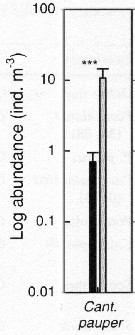 Issued from : S.-H. Hsiao, S. Kâ, T.-H. Fang & J.-S. Hwang inHydrobiologia, 2011, 666. [p.326, Fig.6]. Issued from : S.-H. Hsiao, S. Kâ, T.-H. Fang & J.-S. Hwang inHydrobiologia, 2011, 666. [p.326, Fig.6].
Variations in the most abundant copepod species (mean ± SE) along the transect in the boundary waters between the northern part Taiwan Strait and the East China Sea i March (black bar) and October (grey bar) 2005 (Mann-Whitney U test, sig. ***P <0.001.
See drawings of Hydrological conditions and superficial marine currents in Calanus sinicus. |
 Issued from : M. Madhupratap & P. Haridas in J. Plankton Res., 12 (2). [p.313, Fig.6]. Issued from : M. Madhupratap & P. Haridas in J. Plankton Res., 12 (2). [p.313, Fig.6].
Vertical distribution of calanoid copepod (mean +1 SE), abundance No/100 m3. 65- Canthocalanus pauper.
Night: shaded, day: unshaded.
Samples collected from 6 stations located off Cochin (India), SE Arabian Sea, November 1983, with a Multiple Closing Plankton Net (mesh aperture 300 µm), in vertical hauls at 4 depth intervalls (0-200, 200-400, 400-600, 600-1000 m). |
| | | | Loc: | | | South Africa (E & W, St Lucia estuary, off Cape of Good Hope), Atlant. (in Wolfenden, 1911), Medit. (in Thompson & Scott, 1903), W Egyptian coast (Zakaria & al., 2016 (p.3, Table 1), W Black Sea, Suez Canal, Red Sea, Arabian Sea, Arabian Gulf (UAE coast, Kuwait), Natal, Madagascar (Nosy Bé), Rodrigues Is.- Seychelles, Laccadive Archipelago, W Indian, Goa, Porto Novo, Saurashtra coast, India (E, W, Goa-Gujarat, Bombay, Burhabalanga estuary, Madras, Lawson's Bay, Hooghly estuary), Godavari region, Kakinada Bay), Bay of Bengal, Burma, Nicobar Is., W Malay Peninsula, off Phuket, Perai River estuary, Straits of Malacca, Indonesian Seas, Bintulu coast, Ambon Bay (Baie d'Amboine), Tioman Is., SW Celebes, Philippines, S Mindanao (Sarangani Bay), Viet-Nam (Cauda Bay), Hong Kong, China Seas (Yellow Sea, East China Sea, South China Sea, Xiamen Harbour), Taiwan Strait, Taiwan (S, E, SW, W, Tapong Bay, Kaohsiung Harbor, NW, off Danshuei River, N, Mienhua Canyon, NE), Okinawa, S Korea, Korea Strait, Japan Sea, Japan ( Ariake Bay, Kuchinoerabu Is., Tokyo Bay, Honshu: Suruga Bay), Aleutian Is., Bering Sea, Alaska, off British Columbia, California, Clipperton Is., Pacif. (W equatorial), Australia (G. of Carpentaria, Great Barrier, Brisbane River estuary, Moreton Bay, Shark Bay, North West Cape), New Zealand, Hawaii, New Caledonia, Pacif. (equatorial), Baja California (Bahia Magdalena, W), Gulf of California, Coyuca lagoon (Guerrero), La Paz, W Mexico, Acapulco Bay, G. of Tehuantepec, W Costa Rica, W Colombia, Galapagos-Ecuador, Peru, Chile | | | | N: | 212 | | | | Lg.: | | | (28) F: 1,5-1,25; M: 1,31-1,18; (34) F: 1,68-1,38; M: 1,52-1,35; (35) M: 2,04; (47) F: 1,6-1,3; M: 1,5-1,3; (66) F: 1,47-1,36; M: 1,4-1,37; (78) F: 1,5; M: 1,3; (101) F: 1,46-1,42; M: 1,36; 1,31; (104) F: 1,7; (125) F: 1,62-1,48; M: 1,4; (150) F: 1,52-1,45; M: 1,3-1,27; (290) F: 1,55-1,5; M: 1,55-1,35; (332) F: 1,53-1,43; M: 1,31; (530) F: 1,4-1,1; M: 1,4-1,1; (786) F: 1,75-1,47; M: 1,4-1,34; (795) F: 1,2; M: 1; (937) F: 1,57-1,65; M: 1,42-1,50; (991) F: 1,3-1,6; M: 1,3-1,5; (1047) M: 1,2; (1085) F: 1,4-1,7; M: 1,2-1,5; (1122) F: 1,45; M: 1,4; (1130) M: 1,75; (1230) F: 1,3-1,7; M: 1,2-1,3; {F: 1,10-1,75; M: 1,00-2,04}
The mean female size is 1.526 mm (n = 30; SD = 0.1872), and the mean male size is 1.388 mm (n= 30; SD = 0.1843). The size ratio (male : female) is 0.90.
For Gurney (1927, p.143) the Red Sea form measures 0.68-0.8 mm, whereas that of Port Said is 0.92-1.0 mm, it is clear that there are two independant races meeting in the Suez Canal (except for the size, the differences are negligible); there is no doubt that there are two races which are for the time being, separated by the isthmus, since the Mediterranean form, abundant in the harbour at Port Said, does not extend further up the Suez Canal than El Tineh, where it was very rare, while the Red Sea form was not found north of Timsah. The smaller forms was taken in small numbers in the Gulf of Suez and at Port Taufiq. In the Canal it was present at Km. 152, but was not met with in the Bitter Lakes. Its occurrence at one point in Lake Timsah (Buoy 12 in the Canal) is therefore rather unexpected; the specimens taken bilonged to the small Red Sea race. | | | | Rem.: | Epi-mesopélagique.
La présence en atlantique nécessite confirmation.
Curieusement cette espèce signalée par Thompson & Scott (1903) entre Marseille et Messine, puis entre Messine et Port Said, ne semble pas avoir été retrouvée par la suite en Méditerranée.
Canthocalanus pauper plumulosus Sewell,1912
Ref.: Sewell, 1912 (p.355, Rem.); 1914 a (p.193, Rem.); Früchtl, 1924 b (p.12, figs.M); Sewell, 1929 (p.26: Rem.); Vervoort, 1951 (p.37, Rem.); Krishnaswamy, 1953 (p.108); Silas, 1972 (Rem. p.644); Mauchline, 1987 (p.719)
Loc.: Indien NE
Voir aussi les remarques en anglais | | | Dernière mise à jour : 15/11/2020 | |
|
|
 Toute utilisation de ce site pour une publication sera mentionnée avec la référence suivante : Toute utilisation de ce site pour une publication sera mentionnée avec la référence suivante :
Razouls C., Desreumaux N., Kouwenberg J. et de Bovée F., 2005-2025. - Biodiversité des Copépodes planctoniques marins (morphologie, répartition géographique et données biologiques). Sorbonne Université, CNRS. Disponible sur http://copepodes.obs-banyuls.fr [Accédé le 02 juillet 2025] © copyright 2005-2025 Sorbonne Université, CNRS
|
|
 |
 |























